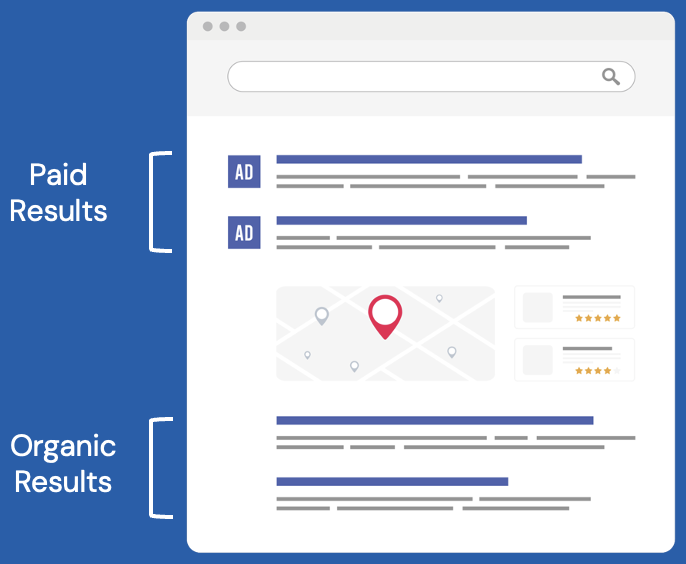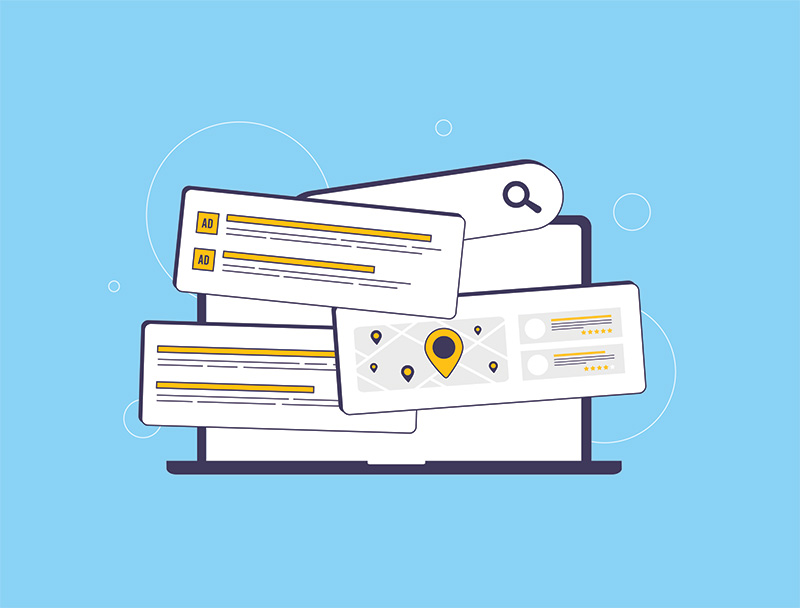SEO and Paid Ads: How They Work in Tandem
Scrolling, searching, clicking—your customers are constantly bouncing between organic results and ads without even realizing it. That’s why brands today can’t just choose between search engine optimization (SEO) or paid ads—they need both working together to win attention and drive results.
SEO builds your long-term online reputation, while Pay-Per-Click (PPC) ads get you quick wins and visibility. When combined, they create a full-funnel marketing approach that attracts, nurtures, and converts customers at every stage of their journey.
In this blog, we’ll break down how SEO and SEM work together, discuss PPC ads on Google, and review the importance of competitor analysis in SEO. At Darwill, we can help you integrate SEO and SEM tools to dominate search engine results pages (SERPs), drive qualified traffic, and maximize your marketing ROI.
What is SEO?
SEO, or search engine optimization, is the process of enhancing a website to improve its visibility on search engines like Google, Bing, and Yahoo. As this is an organic approach, there is no payment for placement on the search engine results page. It’s a long-term strategy focused on organic traffic and growth to help your business attract the right audience with optimized web pages.
Key Components of SEO:
- Keyword Research: Finding the short and long terms your audience uses to search for your products or services. Insights from PPC ads on Google can also be leveraged for your organic strategy. Your paid ad data can show you which keywords actually lead to clicks, leads, or sales, helping you pick target keywords for SEO that are proven to convert.
- On-Page Optimization: Structuring content, meta tags, headers, and internal links for both users and search engines. Doing so will enhance the performance of these pages and help to pull them into SERPs.
- Content Creation: Crafting informative, keyword-rich, and engaging content that addresses the needs of your audience. When adding keywords and key phrases to your content, it’s important to do so naturally. Keyword stuffing with repeating words and phrases detracts from the users experience and can be considered a spammy tactic by search engines.
- Technical SEO: Enhancing site speed, mobile-friendliness, URL structure, and crawlability to improve overall site performance. Make it easy for users to use your website and navigate across it.
- Backlinks: Acquiring high-quality inbound links from reputable sites to boost domain authority. Using credible sources and links will help create trust between your brand and the user.
- Competitor Analysis in SEO: Studying what top-ranking competitors are doing—like the keywords they target, the content they publish, and where they get backlinks—to identify gaps and opportunities in your own strategy.
When implemented correctly, SEO builds trust, improves online visibility, and creates sustainable traffic growth. It’s an essential piece of a smart digital marketing plan that requires consistent maintenance to ensure optimal performance.
What Are Paid Ads?
Paid advertising includes platforms where businesses pay to show their content or offers. The most common form is Pay-Per-Click (PPC), where advertisers bid on keywords in search queries. Your ad only appears if someone searches for the keyword you’ve bid on, and you only pay when they actually click on your ad.
Paid ads can also be utilized on social media and direct to landing pages. Ads can appear in various locations such as feeds, stories, reels, and search pages. Common content types for paid social ads include static images, videos, and carousels.
Popular Paid Ad Channels:
- Google Ads: The most well-known search console platform, offering visibility across Google Search and Display networks.
- Facebook and Instagram Ads: Ideal for targeting based on interests, demographics, and behaviors.
- LinkedIn Ads: Perfect for B2B targeting and professional audience segmentation.
PPC ads on Google provide instant visibility and traffic, making them a preferred choice for new product or service launches, seasonal promotions, or anytime immediate results are needed. Plus, they offer rich data that can inform other areas of your marketing—especially SEO.
How SEO and Paid Ads Complement Each Other
Combining SEO and PPC ads gives businesses the best of both worlds. Here's how they work in tandem:

1. Increased Visibility
With a presence in both paid and organic listings, your business will dominate more screen real estate—boosting trust and click-through rates. When prospects see your brand multiple times on one page, they’re more likely to click and convert.
2. Keyword Data Sharing
SEO and SEM tools, like Google Analytics and Search Console, provide insights into what’s working. You can use high-converting PPC keywords to guide your SEO strategy, and vice versa. This creates a unified keyword plan based on real data.
3. Remarketing Opportunities
Organic traffic from SEO often brings in users across multiple stages of the funnel. When visitors are in the early awareness phase, they are researching products, comparing options, or starting to explore a service. While they may not convert right away, they’ve shown intent and interest.
With paid ads, especially remarketing campaigns, you can reconnect with those visitors after they leave your site. Whether they browsed a service page, read a blog post, or viewed a product, you can serve them targeted ads that match their interests—like limited-time offers, testimonials, or feature highlights. This ongoing engagement helps move them closer to conversion and maximizes the ROI of your SEO efforts.
4. A/B Testing
Before committing to SEO content updates, use PPC ads to test different headlines, calls-to-action, and messaging. PPC’s flexibility allows for quick iterations, giving your SEO efforts a data-backed edge.
5. Funnel Coverage
What is full funnel marketing? It’s a strategy designed to guide potential customers through every stage of their journey—from initial awareness to final decision-making.
Paid ads are especially effective for reaching top-of-funnel audiences with broad messaging and promotions that introduce your brand. SEO, on the other hand, supports the entire funnel—helping users discover your brand during early research, then providing in-depth, trust-building content as they get closer to converting. Together, SEO and SEM tools allow you to deliver the right message at the right time, creating a seamless and effective funnel experience.
When to Invest in Both
Integrating SEO and paid advertising is especially important in these scenarios:
- Launching a new product or business: PPC can generate buzz fast, while SEO lays the groundwork for sustained growth.
- Entering a competitive market: Dominating both paid and organic listings gives you a competitive edge and deters clicks to rivals.
- Needing both quick wins and long-term ROI: Use PPC for immediate leads and SEO for lasting authority and website traffic.
A smart strategy doesn’t pick one over the other—it leverages both to maximize performance and efficiency.
Tips for Aligning SEO and Paid Ads Strategies
To truly see results, your SEO and SEM efforts should be aligned. Here’s how:
- Consistent Messaging and Branding: Make sure your ads and organic content reflect the same voice, visuals, and value propositions. This will help boost your brand awareness.
- Unified Keyword Strategy: Collaborate on keyword planning to avoid overlap and ensure comprehensive coverage.
- Shared Goals and KPIs: Track combined metrics like total traffic, leads, and conversion rates across both channels.
- Regular Data Reviews: Cross-analyze performance data to inform decisions. For example, use competitor analysis in SEO to adjust PPC bids or targeting.
Use SEO and SEM Tools to Enhance Marketing Campaigns
SEO and paid ads are partners in digital marketing success. By combining long-term organic strategies with the precision and speed of paid advertising, businesses can drive more traffic, more leads, and more revenue.
Whether you’re looking to increase visibility, retarget website visitors, or unify your digital efforts into a full-funnel marketing approach, Darwill is here to help. Our team of experts can guide your strategy, manage your campaigns, and deliver results that move the needle.
Reach out to Darwill today to discover how SEO and SEM work together to elevate your marketing.



